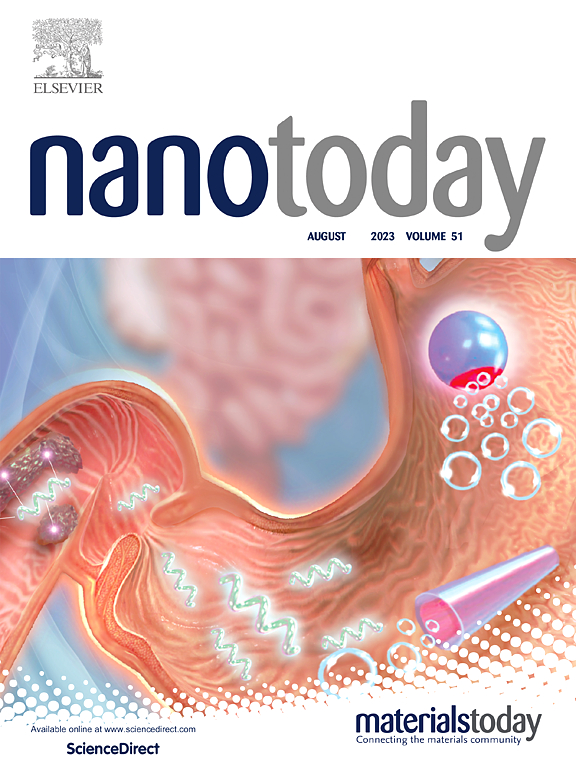An all-in-one polymeric nanomedicine as in situ cascade cancer vaccine for potent cancer immunotherapy
IF 13.2
1区 材料科学
Q1 CHEMISTRY, MULTIDISCIPLINARY
引用次数: 0
Abstract
Cancer vaccines that exploit tumor antigens to induce specific immune responses hold great promise for cancer treatment, with several products already approved. However, limitations such as the lack of tumor-specific antigens, inadequate antigen processing by antigen-presenting cells (APCs), and the suppressive tumor microenvironment significantly hinder their therapeutic efficacy. In this study, we present a cascade cancer vaccine, PAEMA-PCR848, designed for efficient in situ vaccination against cancer in an “all in one” manner. PAEMA-PCR848 rapidly disintegrates in response to the acidic tumor microenvironment, triggering protonation of its core and subsequent release of PEG-modified photosensitizer (PEG-Ce6), poly(2-azepane ethyl methacrylate) (PAEMA), and the immune adjuvant resiquimod (R848), which together elicit a cascade anticancer immune response. The PEG-Ce6 integrates into the phospholipid bilayer of tumor cell membranes, facilitating the release of endogenous tumor-associated antigens (TAAs) and damage-associated molecular patterns (DAMPs). Meanwhile, PAEMA, R848, and the released TAAs migrate to lymph nodes, where they promote the maturation of APCs and the generation of antigen-specific CD8+ T cells. Additionally, R848 promotes M1 polarization of macrophages within the tumor microenvironment, enhancing tumor cell engulfment and modulating immune suppression. Notably, this cascade nanovaccine resulted in the complete eradication of distant tumors in some mice and induced long-term immune memory, providing potent protection against tumor recurrence and metastasis.
一种多功能聚合纳米药物作为原位级联癌症疫苗,用于强效癌症免疫治疗
利用肿瘤抗原诱导特异性免疫反应的癌症疫苗在癌症治疗中具有很大的前景,已有几种产品获得批准。然而,诸如缺乏肿瘤特异性抗原、抗原呈递细胞(APCs)抗原加工不足以及肿瘤微环境的抑制性等局限性显著阻碍了其治疗效果。在这项研究中,我们提出了一种级联癌症疫苗PAEMA-PCR848,旨在以“all In one”的方式有效地原位接种癌症。PAEMA- pcr848在酸性肿瘤微环境下迅速分解,触发其核心质子化,随后释放peg修饰的光敏剂(PEG-Ce6)、聚(2-甲基丙烯酸乙酯)(PAEMA)和免疫佐剂雷西喹mod (R848),共同引发级联抗癌免疫反应。PEG-Ce6整合到肿瘤细胞膜的磷脂双分子层,促进内源性肿瘤相关抗原(TAAs)和损伤相关分子模式(DAMPs)的释放。同时,PAEMA、R848和释放的TAAs迁移到淋巴结,促进apc的成熟和抗原特异性CD8+ T细胞的产生。此外,R848促进肿瘤微环境内巨噬细胞M1极化,增强肿瘤细胞吞噬,调节免疫抑制。值得注意的是,这种级联纳米疫苗在一些小鼠中完全根除了远处肿瘤,并诱导了长期免疫记忆,为防止肿瘤复发和转移提供了有效的保护。
本文章由计算机程序翻译,如有差异,请以英文原文为准。
求助全文
约1分钟内获得全文
求助全文
来源期刊

Nano Today
工程技术-材料科学:综合
CiteScore
21.50
自引率
3.40%
发文量
305
审稿时长
40 days
期刊介绍:
Nano Today is a journal dedicated to publishing influential and innovative work in the field of nanoscience and technology. It covers a wide range of subject areas including biomaterials, materials chemistry, materials science, chemistry, bioengineering, biochemistry, genetics and molecular biology, engineering, and nanotechnology. The journal considers articles that inform readers about the latest research, breakthroughs, and topical issues in these fields. It provides comprehensive coverage through a mixture of peer-reviewed articles, research news, and information on key developments. Nano Today is abstracted and indexed in Science Citation Index, Ei Compendex, Embase, Scopus, and INSPEC.
 求助内容:
求助内容: 应助结果提醒方式:
应助结果提醒方式:


